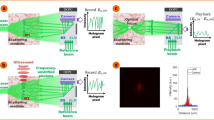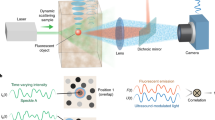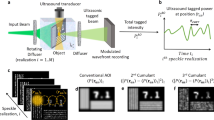Abstract
Focusing of light in the diffusive regime inside scattering media has long been considered impossible. Recently, this limitation has been overcome with time reversal of ultrasound-encoded light (TRUE), but the resolution of this approach is fundamentally limited by the large number of optical modes within the ultrasound focus. Here, we introduce a new approach, time reversal of variance-encoded light (TROVE), which demixes these spatial modes by variance encoding to break the resolution barrier imposed by the ultrasound. By encoding individual spatial modes inside the scattering sample with unique variances, we effectively uncouple the system resolution from the size of the ultrasound focus. This enables us to demonstrate optical focusing and imaging with diffuse light at an unprecedented, speckle-scale lateral resolution of ∼5 µm.
This is a preview of subscription content, access via your institution
Access options
Subscribe to this journal
Receive 12 print issues and online access
$209.00 per year
only $17.42 per issue
Buy this article
- Purchase on Springer Link
- Instant access to full article PDF
Prices may be subject to local taxes which are calculated during checkout




Similar content being viewed by others
References
Mosk, A. P., Lagendijk, A., Lerosey, G. & Fink, M. Controlling waves in space and time for imaging and focusing in complex media. Nature Photon. 6, 283–292 (2012).
Freund, I. Looking through walls and around corners. Physica A 168, 49–65 (1990).
Vellekoop, I. M., Lagendijk, A. & Mosk, A. P. Exploiting disorder for perfect focusing. Nature Photon. 4, 320–322 (2010).
Vellekoop, I. M. & Mosk, A. P. Focusing coherent light through opaque strongly scattering media. Opt. Lett. 32, 2309–2311 (2007).
Katz, O., Small, E. & Silberberg, Y. Looking around corners and through thin turbid layers in real time with scattered incoherent light. Nature Photon. 6, 549–553 (2012).
Katz, O., Small, E., Bromberg, Y. & Silberberg, Y. Focusing and compression of ultrashort pulses through scattering media. Nature Photon. 5, 372–377 (2011).
Van Putten, E. G. et al. Scattering lens resolves sub-100 nm structures with visible light. Phys. Rev. Lett. 106, 193905 (2011).
Aulbach, J., Gjonaj, B., Johnson, P. M., Mosk, A. P. & Lagendijk, A. Control of light transmission through opaque scattering media in space and time. Phys. Rev. Lett. 106, 13901 (2011).
Lerosey, G., De Rosny, J., Tourin, A. & Fink, M. Focusing beyond the diffraction limit with far-field time reversal. Science 315, 1120–1122 (2007).
Yaqoob, Z., Psaltis, D., Feld, M. S. & Yang, C. H. Optical phase conjugation for turbidity suppression in biological samples. Nature Photon. 2, 110–115 (2008).
Popoff, S., Lerosey, G., Fink, M., Boccara, A. C. & Gigan, S. Image transmission through an opaque material. Nature Commun. 1, 81 (2010).
Popoff, S. M. et al. Measuring the transmission matrix in optics: an approach to the study and control of light propagation in disordered media. Phys. Rev. Lett. 104, 100601 (2010).
Cizmar, T. & Dholakia, K. Exploiting multimode waveguides for pure fibre-based imaging. Nature Commun. 3, 1027 (2012).
Choi, Y. et al. Scanner-free and wide-field endoscopic imaging by using a single multimode optical fiber. Phys. Rev. Lett. 109, 203901 (2012).
Choi, W., Mosk, A. P., Park, Q. H. & Choi, W. Transmission eigenchannels in a disordered medium. Phys. Rev. B 83, 134207 (2011).
Hsieh, C. L., Pu, Y., Grange, R. & Psaltis, D. Digital phase conjugation of second harmonic radiation emitted by nanoparticles in turbid media. Opt. Express 18, 12283–12290 (2010).
Vellekoop, I. M., Cui, M. & Yang, C. H. Digital optical phase conjugation of fluorescence in turbid tissue. Appl. Phys. Lett. 101, 081108 (2012).
Tao, X. et al. Adaptive optics microscopy with direct wavefront sensing using fluorescent protein guide stars. Opt. Lett. 36, 3389–3391 (2011).
Xu, X., Liu, H. & Wang, L. V. Time-reversed ultrasonically encoded optical focusing into scattering media. Nature Photon. 5, 154–157 (2011).
Lai, P., Xu, X., Liu, H., Suzuki, Y. & Wang, L. V. Reflection-mode time-reversed ultrasonically encoded optical focusing into turbid media. J. Biomed. Opt. 16, 080505 (2011).
Liu, H., Xu, X., Lai, P. & Wang, L. V. Time-reversed ultrasonically encoded optical focusing into tissue-mimicking media with thickness up to 70 mean free paths. J. Biomed. Opt. 16, 086009 (2011).
Wang, Y. M., Judkewitz, B., DiMarzio, C. A. & Yang, C. H. Deep-tissue focal fluorescence imaging with digitally time-reversed ultrasound-encoded light. Nature Commun. 3, 928 (2012).
Si, K., Fiolka, R. & Cui, M. Fluorescence imaging beyond the ballistic regime by ultrasound-pulse-guided digital phase conjugation. Nature Photon. 6, 657–661 (2012).
Bertolotti, J. et al. Non-invasive imaging through opaque scattering layers. Nature 491, 232–234 (2012).
Si, K., Fiolka, R. & Cui, M. Breaking the spatial resolution barrier via iterative sound–light interaction in deep tissue microscopy. Sci. Rep. 2, 748 (2012).
Conkey, D. B., Caravaca-Aguirre, A. M. & Piestun, R. High-speed scattering medium characterization with application to focusing light through turbid media. Opt. Express 20, 1733–1740 (2012).
Redding, B., Choma, M. A. & Cao, H. Speckle-free laser imaging using random laser illumination. Nature Photon. 6, 355–359 (2012).
Draijer, M., Hondebrink, E., Leeuwen, T. & Steenbergen, W. Review of laser speckle contrast techniques for visualizing tissue perfusion. Lasers Med. Sci. 24, 639–651 (2009).
Hajjarian, Z., Xi, J., Jaffer, F. A., Tearney, G. J. & Nadkarni, S. K. Intravascular laser speckle imaging catheter for the mechanical evaluation of the arterial wall. J. Biomed. Opt. 16, 026005 (2011).
Lev, A. & Sfez, B. In vivo demonstration of the ultrasound-modulated light technique. J. Opt. Soc. Am. A 20, 2347–2354 (2003).
Cui, M., McDowell, E. J. & Yang, C. An in vivo study of turbidity suppression by optical phase conjugation (TSOPC) on rabbit ear. Opt. Express 18, 25–30 (2010).
Yamaguchi, I. & Zhang, T. Phase-shifting digital holography. Opt. Lett. 22, 1268–1270 (1997).
Acknowledgements
The authors thank I. Vellekoop for discussions and P. Willems for comments on the manuscript. B.J. is recipient of a Sir Henry Wellcome Fellowship from the Wellcome Trust. Y.M.W. acknowledges support from the National Science Scholarship, awarded by the Agency for Science, Technology and Research, Singapore. This work is supported by the National Institutes of Health (1DP2OD007307-01) and the Defense Advanced Research Projects Agency (W31P4Q-11-1-0008).
Author information
Authors and Affiliations
Contributions
B.J. and Y.M.W. contributed equally to this work. B.J. conceived the idea. B.J. and Y.M.W. developed the idea, with the help of R.H., A.M. and C.Y. The experiment was designed by B.J. and Y.M.W., who also built the set-up, collected data, performed the simulation and data analysis, and wrote the manuscript. R.H. contributed to the manuscript and to the simulation results. R.H. and A.M. contributed to analysis and mathematical derivation. C.Y. supervised the project and contributed to the manuscript.
Corresponding authors
Ethics declarations
Competing interests
The authors declare no competing financial interests.
Supplementary information
Supplementary information
Supplementary information (PDF 1272 kb)
Rights and permissions
About this article
Cite this article
Judkewitz, B., Wang, Y., Horstmeyer, R. et al. Speckle-scale focusing in the diffusive regime with time reversal of variance-encoded light (TROVE). Nature Photon 7, 300–305 (2013). https://doi.org/10.1038/nphoton.2013.31
Received:
Accepted:
Published:
Issue Date:
DOI: https://doi.org/10.1038/nphoton.2013.31
This article is cited by
-
Phase conjugation with spatially incoherent light in complex media
Nature Photonics (2023)
-
High-resolution non-line-of-sight imaging employing active focusing
Nature Photonics (2022)
-
Depth-targeted energy delivery deep inside scattering media
Nature Physics (2022)
-
Imaging in complex media
Nature Physics (2022)
-
High-fidelity spatial mode transmission through a 1-km-long multimode fiber via vectorial time reversal
Nature Communications (2021)



